About

Hi, welcome!
I'm an ecologist and PhD student working out of the Germain lab at UBC.
Although trained as a biologist, my interests are extremely broad. This is because, at the root of it all, I'm deeply fascinated
in the nature of complexity. Put simply, complexity can be anecdotally captured by the phrase: the whole is greater than the sum of its parts.
In more jargony terms, it's the apparent separation between the microstates and macrostates of a system. This suggests that conventional
reductionist approaches, of which we are so used to in science, may offer little to our investigations. It's not unlike trying to clap your hands underwater!
As you may have noticed, complexity is everywhere, but it is particularly abundant in living sytems - systems that despite the inevitability of entropy
increase, manages to maintain itself out-of-equilibrium. We see it in our economy, our society, the internet, the climate, and even in our
bodies (the collection of cells and microorganisms that make up us!). My premise is that all these things are the result of biological processes governed
by the ecologies of organisms and their environment, which have been and continue to be sculpted by Darwinian evolution. If this premise holds,
I believe ecology and evolution offers endless opportunities for scientific discovery and allows us to get a glimpse of the inner workings of nature herself.
For my PhD research, I'm trying to understand how ecologically-similar species coexist. Coexistence of similiar species is a paradox because one of the
central tenet of competition theory is that stable coexistence is permitted only when competiting species occupy different niches. The standard response to
this paradox is that there are unobserved/cryptic envrionmental variability that promotes coexistence, emphasizing the role of exogenous envrionmental factors
in determining species persistence. I would like to explore an alternative (but compatible!) explanation: that the environment that promotes persistence are, in part,
shaped by activities of the organisms that inhabit it. How? My hypothesis is that the answer lies in information. Unlike inanimate objects, organisms have the
capacity to sense their envrionment, find regularities in it, and act upon it to guide adaptive behaviour. In this way, organisms are not
fully constrained by their environment, they have the capacity to modify it and alter how they experience it. As the late evolutionary biologist Richard Lewontin puts it:
"Natural selection is not a consequence of how well the organism solves a set of fixed problems posed by the envrionment; on the contrary, the environment and the organism actively
codetermine each other"
I'm currently trying to incorporate aspects of information use into niche theory by building mathematical models, running computer simulations, and experimenting with microbes 🧑🏻💻🦠. If any of these things sound
interesting to you, feel free to contact me or check back here for updates!
I occasionally write/blog about things: 1) Simulating ecology
2) Predator-Prey, 3) Biology computing, 4) Ideas that need retiring
Research

* - Equal contribution
† - Shared senior authorship
Information and species coexistence
Coming soon...
Writing accessible theory in Ecology and Evolution
Science operates on a heatlhy feedback between theory and experimentation. However, theories are often formalized in the form of mathematics,
which render them inaccessible to those lacking formal training. In this paper, we outline a list of recommendations, based on
Cognitive Load theory, that provides theoreticians concrete ways in which they can make their work more acceesible, thereby strengthening the link
between theory and experimentation.
*Ou, WJ-A, *Henriques, GJB, Senthilnathan, A, Ke, P-J, †Grainger, TN, †Germain, RM. 2022.
Writing Accessible Theory in Ecology and Evolution: Insights from Cognitive Load Theory. BioScience. [paper]
Paddy field agroecology
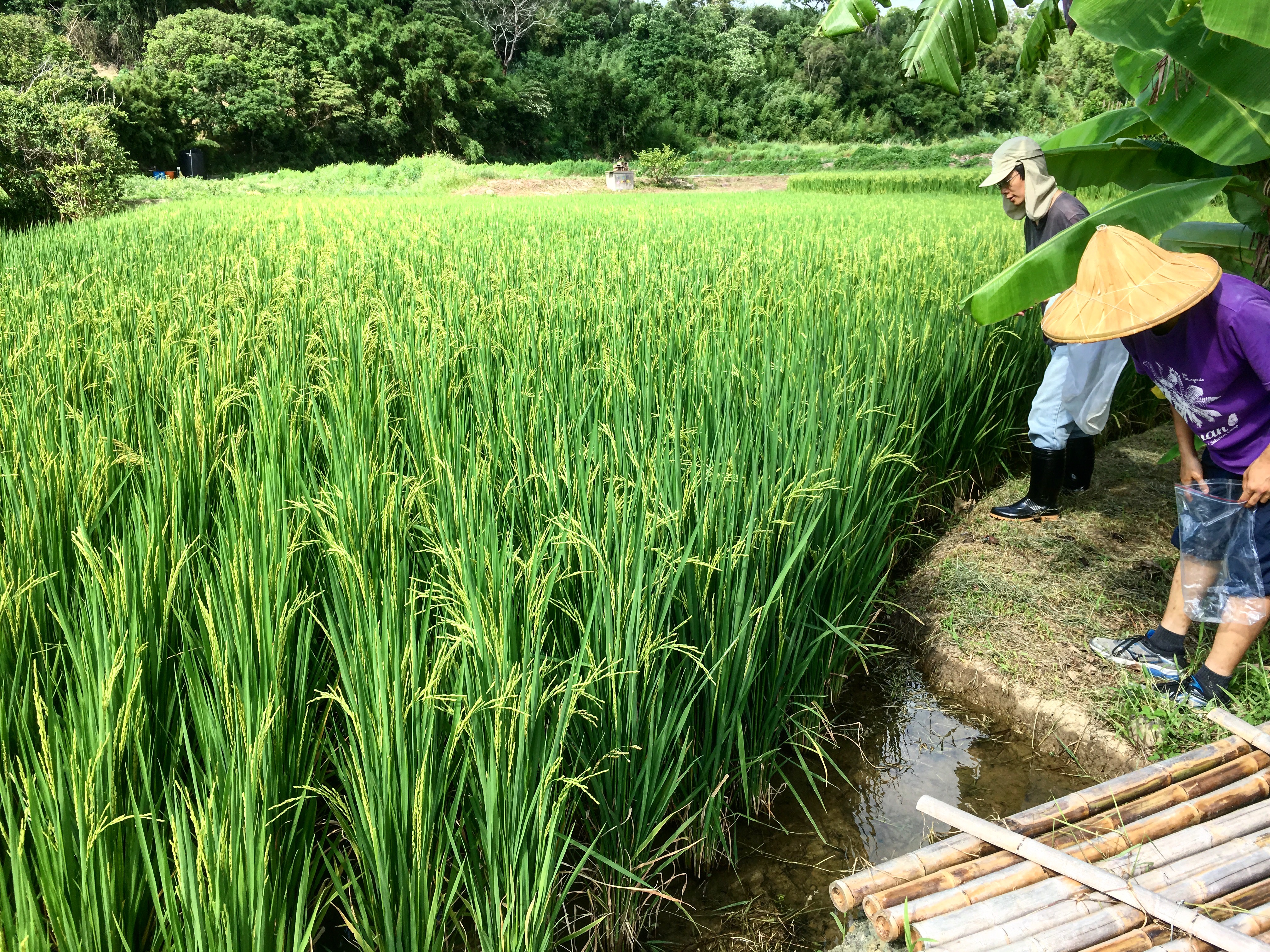
1. Trophic interactions with stable isotopes
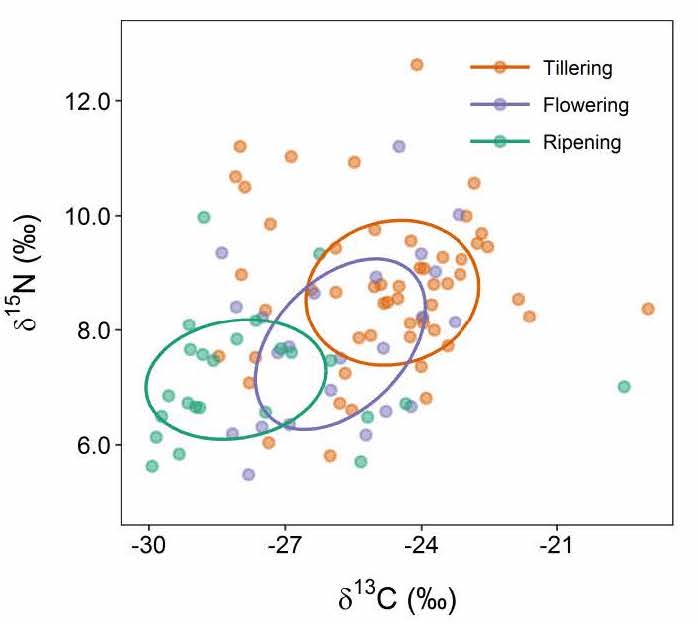
Due to their low prey specificity, generalist arthropod predators are often neglected as potential biocontrol agents in agro-ecosystems.
Furthermore, their inconspicuous feeding habits can be hard to quantify under field conditions. To overcome this limitation, we use
stable isotope analysis, which provides time-integrated dietery information, to shed light on the inconspicuous trophic interactions
betweeen generalist predators and their prey. As expected, generalist predators shift their diets over the course of the cropping season
and these trends were consistent across different farming systems.
Hsu, G-C, Ou, J-A, Ho, C-K. 2021. Pest consumption by generalist arthropod predators increases with
crop stage in both organic and conventional farms. Ecosphere. [DOI]
2. Arthropod biodiversity across scales
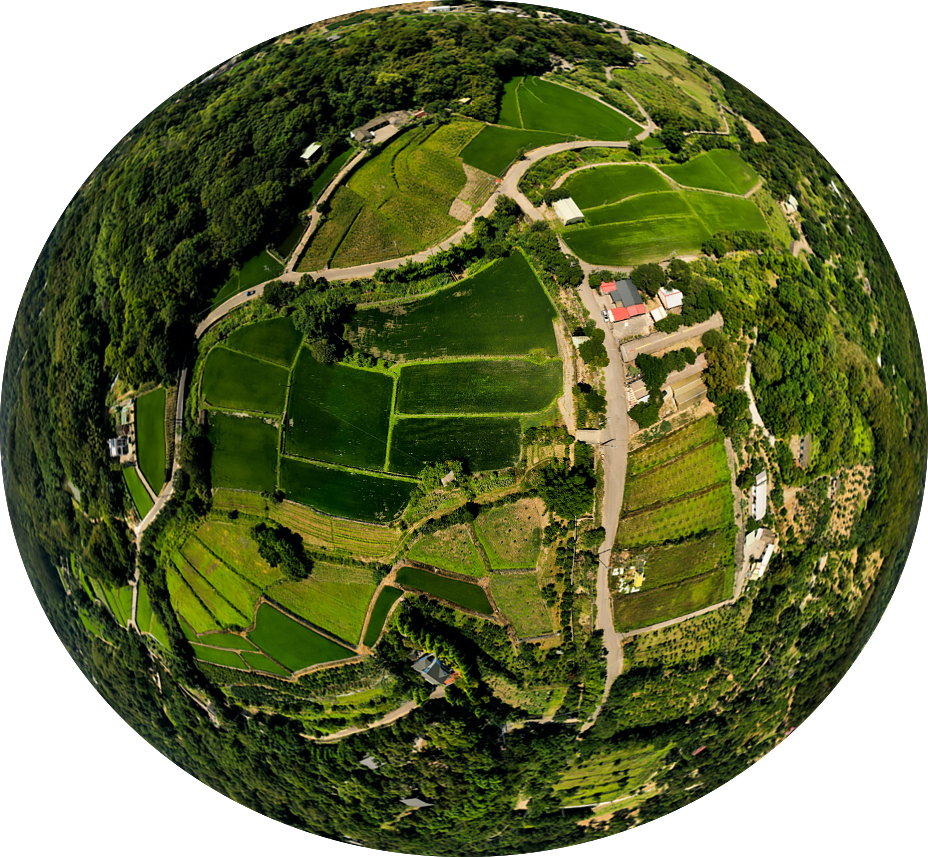
Agro-ecosystems are complex dynamic mosaics where environmental heterogeneity vary across spatial scales. Moreover,
species can differ in their responses to environmental conditions of varying spatial scales, which ultimately affects
the diversity and composition of ecological communities. In this study, we show that paddy field inhabiting
arthropods show only weak responses to local factors such as organic farming and crop height. In contrast, most species
show strong positive responses to forest cover in the surrounding matrix. These general responses were true even
for species of different trophic groups.
Ou, J-A, Huang, C-L, Chen, H-J, Tsai, C-W, Ho, C-K. 2021 Effects of local and landscape factors on arthrpod diversity: from species to communities. In prep
Plant-animal interactions
1. Effects of plant water stress on multitrophic arthroprod communities
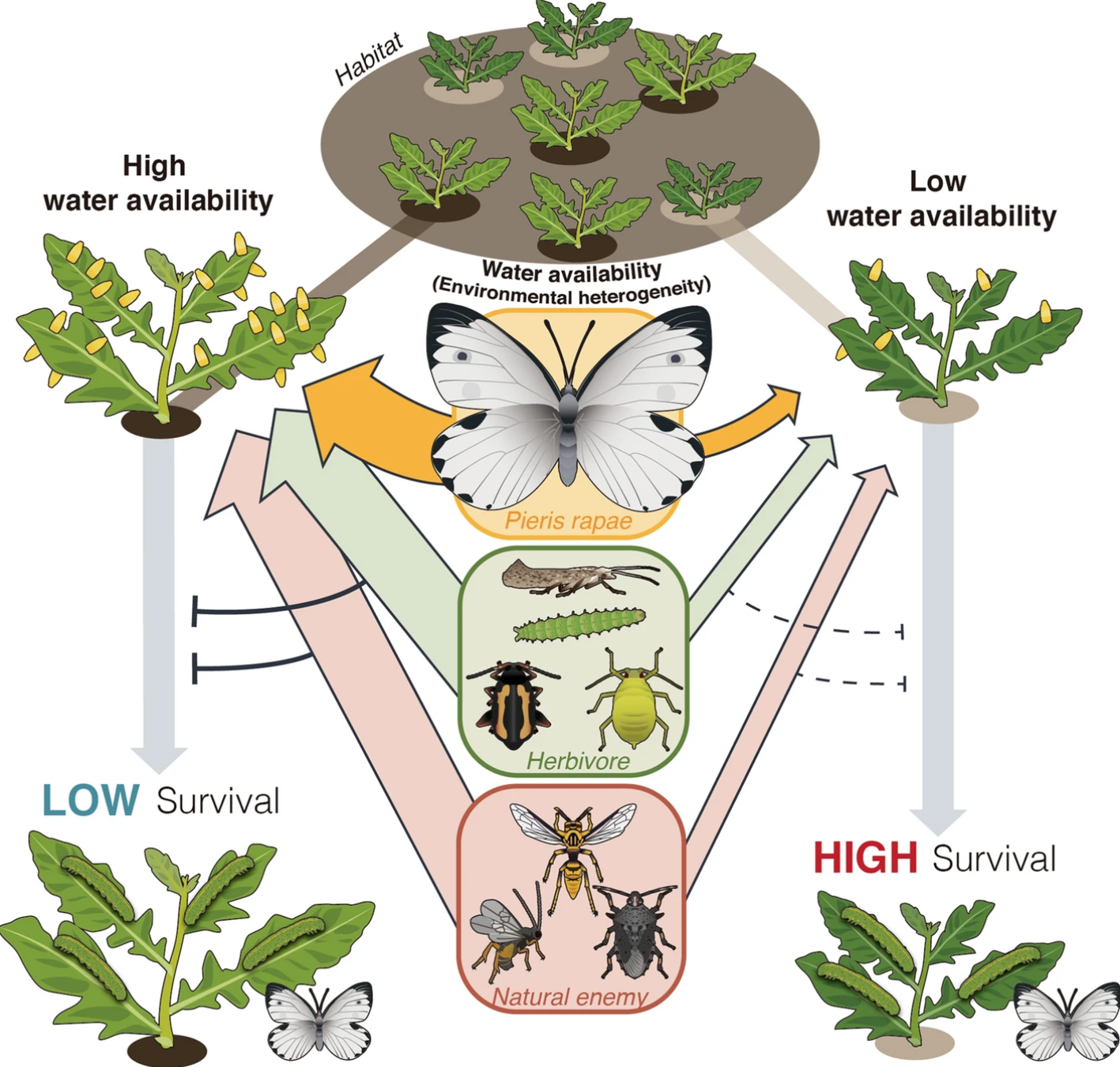
The association between drought and insect outbreaks is a well-documented phenomenon but its generality across other
plant-insect herbivore systems remains unknown. In this study, we conducted a field experiment showing that the
impact of water stress on herbivore performance is highly dependent on animal community and species interactions.
Specifically, the negative effects of plant water stress on Pierid larvae performance was the result of species
interaction (competition and predation) and not changes in plant quality. Read more here:
*Lin, P-A, *Liu, C-M, *Ou, J-A, Sun, C.-H., Chuang, W.-P., Ho, C.-K., Kinoshita, N., & Felton, G. W.
(2021). Changes in arthropod community but not plant quality benefit a specialist herbivore on plants
under reduced water availability. Oecologia. [DOI]
2. Direct and indirect effects of warming and predation on aphid population dynamics
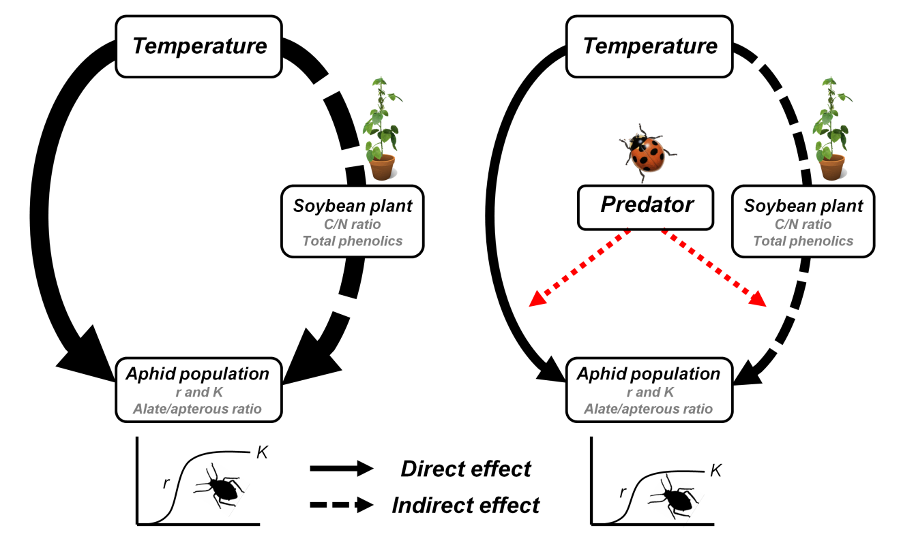
Natural ecological communities contain multiple interacting species. As such, impacts of environmental change
can be hard to predict because environmental change can affect species both directly and/or indirectly through species
interactions. In this study, we applied structural equation modeling to decompose the direct and indirect effects of
experimental warming on aphid population dynamics in a lady beetle-aphid-soy bean tri-trophic system. Our preliminary
results show that plant-mediated indirect effects were negligible and that warming affected aphid population dynamics
mainly through direct effects on intrinsic growth rate and alate/apterous ratio
CV

Aenean ornare velit lacus, ac varius enim ullamcorper eu. Proin aliquam facilisis ante interdum congue. Integer mollis, nisl amet convallis, porttitor magna ullamcorper, amet egestas mauris. Ut magna finibus nisi nec lacinia. Nam maximus erat id euismod egestas. By the way, check out my awesome work.
Lorem ipsum dolor sit amet, consectetur adipiscing elit. Duis dapibus rutrum facilisis. Class aptent taciti sociosqu ad litora torquent per conubia nostra, per inceptos himenaeos. Etiam tristique libero eu nibh porttitor fermentum. Nullam venenatis erat id vehicula viverra. Nunc ultrices eros ut ultricies condimentum. Mauris risus lacus, blandit sit amet venenatis non, bibendum vitae dolor. Nunc lorem mauris, fringilla in aliquam at, euismod in lectus. Pellentesque habitant morbi tristique senectus et netus et malesuada fames ac turpis egestas. In non lorem sit amet elit placerat maximus. Pellentesque aliquam maximus risus, vel sed vehicula.
Contact
Elements
Text
This is bold and this is strong. This is italic and this is emphasized.
This is superscript text and this is subscript text.
This is underlined and this is code: for (;;) { ... }. Finally, this is a link.
Heading Level 2
Heading Level 3
Heading Level 4
Heading Level 5
Heading Level 6
Blockquote
Fringilla nisl. Donec accumsan interdum nisi, quis tincidunt felis sagittis eget tempus euismod. Vestibulum ante ipsum primis in faucibus vestibulum. Blandit adipiscing eu felis iaculis volutpat ac adipiscing accumsan faucibus. Vestibulum ante ipsum primis in faucibus lorem ipsum dolor sit amet nullam adipiscing eu felis.
Preformatted
i = 0;
while (!deck.isInOrder()) {
print 'Iteration ' + i;
deck.shuffle();
i++;
}
print 'It took ' + i + ' iterations to sort the deck.';
Lists
Unordered
- Dolor pulvinar etiam.
- Sagittis adipiscing.
- Felis enim feugiat.
Alternate
- Dolor pulvinar etiam.
- Sagittis adipiscing.
- Felis enim feugiat.
Ordered
- Dolor pulvinar etiam.
- Etiam vel felis viverra.
- Felis enim feugiat.
- Dolor pulvinar etiam.
- Etiam vel felis lorem.
- Felis enim et feugiat.
Icons
Actions
Table
Default
| Name |
Description |
Price |
| Item One |
Ante turpis integer aliquet porttitor. |
29.99 |
| Item Two |
Vis ac commodo adipiscing arcu aliquet. |
19.99 |
| Item Three |
Morbi faucibus arcu accumsan lorem. |
29.99 |
| Item Four |
Vitae integer tempus condimentum. |
19.99 |
| Item Five |
Ante turpis integer aliquet porttitor. |
29.99 |
|
100.00 |
Alternate
| Name |
Description |
Price |
| Item One |
Ante turpis integer aliquet porttitor. |
29.99 |
| Item Two |
Vis ac commodo adipiscing arcu aliquet. |
19.99 |
| Item Three |
Morbi faucibus arcu accumsan lorem. |
29.99 |
| Item Four |
Vitae integer tempus condimentum. |
19.99 |
| Item Five |
Ante turpis integer aliquet porttitor. |
29.99 |
|
100.00 |




